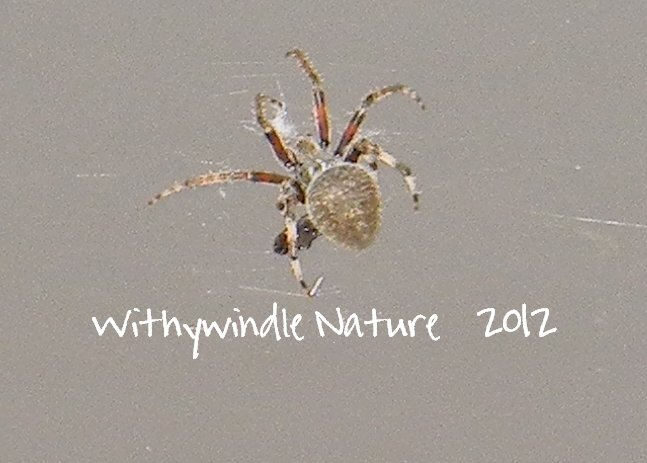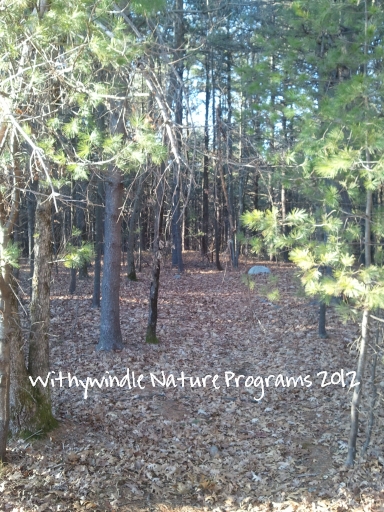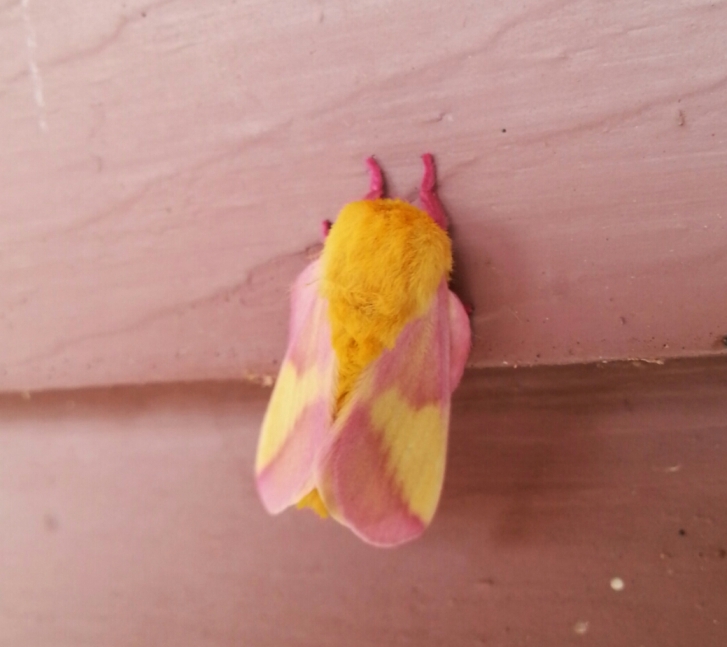Below are notes I took on the second-to-last night of our New York vacation. We spent the last few days down in lower Westchester county at my father’s house, and while playing cards that night with Obo and my step-mother I noticed this very large spider constructing her web. After we finished up the game, I stayed to watch and took notes on my observations.
7-14-12, Mam’k, NY, 9:55 PM. Waning moon.
I’m watching a large – 1.25″ – spider in her web outside a large bay window. The window gives me a great vantage of my subject – I can get right up close to her and observe her actions, while still having a pane of glass between us. Obo took some pictures of her from outside (below). She has a large and heavy abdomen, gray and fuzzy with long, slender legs that are banded brown, white and black. Her web is over 18″ in diameter, orb-weaver type.
I watched her building her web for over 50 minutes. How often does she do this task? The amount of energy needed to both produce the thread and create the web itself must be considerable. Is it a nightly activity? [note: web was gone the following morning; my resource (see below) says they build at night, but not whether it’s every night; I suspect that it is.] I know so little about spiders. Their lives are pretty short, but she’s a biggie. Is she longer lived than the average cellar-dweller types I find in our house? They only seem to live for a week or two at most once they appear [Yes, spiders live in my house unmolested. I follow the belief that it’s bad luck to kill them, and besides, the service they provide – eating the flying things that make their way in – is a plus.].
How fast she is! To get to a lower section of web, she throws a line out and sails down. But she’s no slower coming back up – all eight legs flying.
There’s a larger (than the few already caught) insect causing havoc to the web as it bounces off the window. The spider scuttles [is there any better word for how spiders move?] to the center where she waits out the movement. She’s caught it! Her legs move almost too fast to see as she wraps up this big new catch. I am simply amazed at her speed – ferocious, it seems. She is definitely a fearsome predator.
A moth, eyes glowing orange in the reflected light of the lamp, lands on the window. It is big enough to destroy the well-made web, but it deftly avoids getting snared as it first lands on, then flies away from the window.
I can’t tell what her newest catch is. She didn’t wrap it up completely, as she did the smaller ones – only enough to immobilize it. It is nearly Japanese Beetle in size and shape, a bit smaller.
I’ve been watching her feed on her second catch (not the beetle) for a while now. It landed to the right of center on the web, and she wrapped it up and left it there while finishing the construction of her web. When that was finished, she brought her prey to the center of the web and began consuming it. At some point I believe she removed the thread that it was encased in, and it became a black, glistening mass in her pincers. How much of their prey do spiders consume? Does it differ with different species? I had the impression that spiders only drained them of their internal fluids, but the size and shame of her prey has changed while I’ve watched; its shrunken and collapsed. It’s nearly gone now, I can’t even tell if there’s anything there, or if I’m looking at a part of her underbelly. No, it’s gone now – did she really consume the whole thing? That would explain the removing of the thread when she began (if that’s what she did).
Now she appears to be cleaning her front legs. It’s a delicate and almost cat-like movement; she uses her front pincers to help.
Web-building and feeding are done and she rests now, hanging upside down in the center of her web, motionless. She is a fascinating, beautiful and frightful marvel of nature.






Beautiful shot of the spider spinning its web and I also love the shot of you watching it. Very interesting narrative too.
Thanks Carver!
Cynthia..and these are the notes I should be taking,, but you have more patience than I do to sit and record, but I should. This is an inspiration to me….You would like Bug Eric’s blog..he is the author on an insect guide…
http://bugeric.blogspot.com/
Thank you, Michelle. I don’t always have the patience – it takes a lot of effort to keep my mind from wandering most times. Interestingly, I find my desire to sit and observe growing as I get older… maybe I’m settling down or something. 🙂
What a cool looking spider and in a great place for you to watch and take your photos.
She is pretty cool looking… much more so from behind a pane of glass. 🙂 Thanks for visiting, Eileen!
You made your observations into a great story and I really like the shot of you spider-watching.
Spiders really do only consume the innards of their prey, after they have liquefied it with digestive juices. Some species help that process along by kneading their prey with their mouthparts (and some use a huge amount of silk to crush their prey).
With prey that has only a very soft exoskeleton, I believe it’s possible that the whole insect dissolves, but usually the shell is left, crumbling away, and the spider cuts it from her net once it’s empty.
I know that the European garden spider, an orb-weaver like yours, likes for a year. They are born near the end of summer, live through the winter and then mate and die in the next summer. And yes, they do make a new net every night usually.
Have you ever watched a jumping spider? They are awesome little creatures and will look back at you, they have amazing eyesight and can tackle prey muh bigger than themselves. They are also among the most colourful spiders and have a very cool mating dance. For different methods of catching prey, google bola spiders or net casting spiders (who are also called ogre faced spiders) Or trap door spiders (another video from David Attenborough’s Life in the Undergrowth, I can highly recommend the whole series).
Jennifer – thank you for the information and resources. After going through my own library, I realized I had a real lack of resources on spiders. Most are insects-only, and the one guide I have that focuses on spiders is pretty small. I’ll definitely check out the jumping spiders and trap door spiders. I only know the basics about them – I find the whole group absolutely fascinating. Thanks for visiting!
I loved this post. We have so many spiders around my house, it makes me want to stop and watch them a bit longer. My husband came across two big ones while he was taking out some lattice under our front porch. He took some pics. Maybe I’ll share for Windows on Wildlife. 🙂
I’d love to see the spiders your husband found! You should definitely post them for Windows on Wildlife next week!
When you stop to think about how they live and what they do, spiders really are pretty amazing. Watching this one her create her web was just incredible – for the amount of time and energy it takes, and to do it every night it is impressive.
Pretty amazing critter!